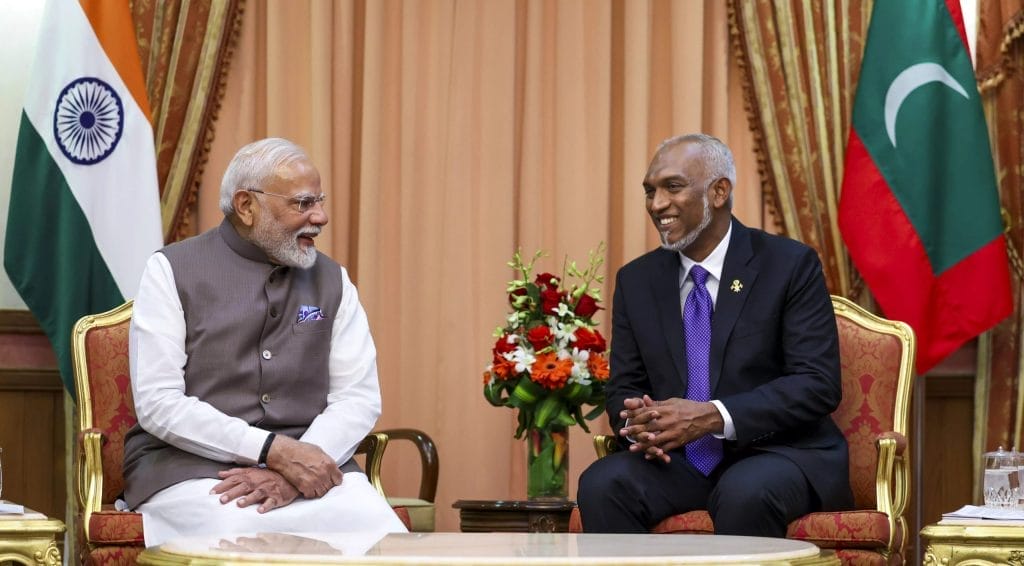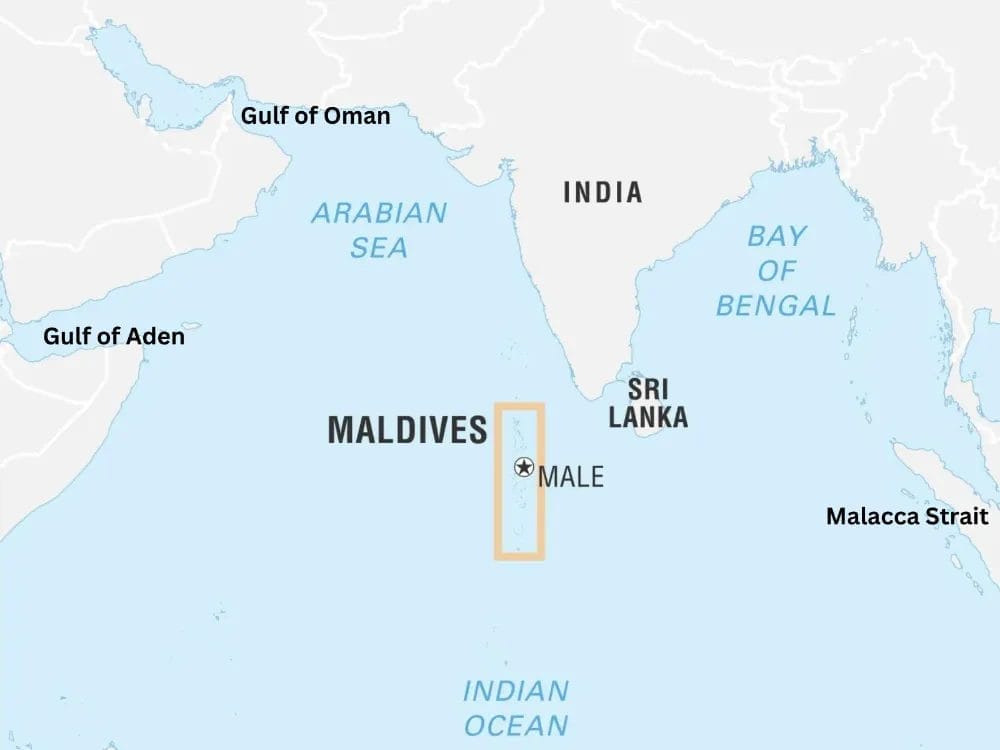
Why in News:
PM Modi, who was in the Maldives on a two-day state visit, held talks with top Maldivian leaders across the political spectrum. He also attended the island nation’s 60th Independence Day event in its capital, Male.


UPSC CSE Relevance:
UPSC CSE in Mains examination has focused on India and its neighborhood- relations. A case in point is a following PYQ.
UPSC Mains PYQ 2022:
‘India is an age-old friend of Sri Lanka.’ Discuss India’s role in the recent crisis in Sri Lanka in the light of the preceding statement.
UPSC Mains PYQ 2013:
Discuss the political developments in Maldives in the last two years. Should they be of any cause of concern to India?
Historical Evolution:
Early Connections & Pre-Independence:
- Ancient Times: Historical and cultural links trace back centuries, with Buddhism spreading from India to the Maldives and influencing language and customs.
- British Protectorate Period (1887-1965): Both nations were under British influence, indirectly shaping their initial interactions.
Post-Independence: Establishing Diplomatic Ties & Strong Foundations (1960s-1990s):
- 1965: Maldives gains independence. India is among the first countries to recognize its independence and establish diplomatic relations. This marks the beginning of formal bilateral engagement.
- 1972: India establishes its mission in Malé.
- 1976: The Maritime Boundary Treaty resolves the one-time claim of Maldives to Minicoy Island, with Maldives recognizing Minicoy as an integral part of India.
- 1988: Operation Cactus: This is a watershed moment. India swiftly responds to a coup attempt by Sri Lankan Tamil militants at the Maldives’ request, showcasing India’s commitment to Maldivian security and sovereignty. The immediate withdrawal of Indian troops after the operation assuages fears of Indian dominance.
Strengthening Cooperation & Development Partnership (2000s-2010s):
- 2004: Indian Ocean Tsunami: India is among the first to provide immediate relief and assistance to the Maldives, further solidifying its role as a “first responder” in the region.
- 2004: Maldives opens a full-fledged High Commission in New Delhi.
- 2008: Mohamed Nasheed is democratically elected President, leading to a cordial relationship with India. India pledges a $100 million loan for tourism.
- 2008: Signing of the ‘Agreement on Cooperation in Defence’ formalizes defense cooperation, including training and joint exercises.
- 2011: Free Trade Agreement (FTA) negotiations begin, signaling an intent to deepen economic ties (though not concluded at this point).
- 2012: President Nasheed’s government falls, leading to a period of political instability.
- 2013-2018 (Yameen Presidency): While the Yameen government initially adopts an ‘India First’ policy, this period also sees some strain in relations due to increasing Chinese influence in the Maldives.
- 2014: Malé Water Crisis: India is the first to assist Maldives during a severe water crisis, demonstrating its proximity and capacity to help in distress.
- 2018: Ibrahim Mohamed Solih assumes office, ushering in an era of renewed closeness with India. Solih prioritizes an ‘India-First’ policy, leading to a significant reset in relations.
- 2019: Multiple high-level visits between Indian Prime Minister Modi and Maldivian President Solih, with the signing of various agreements on development assistance, connectivity, and maritime security, including the Greater Malé Connectivity Project.
Recent Developments & Challenges (2020s-Present):
- 2020: Launch of cargo vessel service between the two countries, boosting bilateral trade.
- 2021: India provides 100,000 Covishield vaccines to Maldives during the COVID-19 pandemic. India also supplies 6.2 tonnes of essential medicines through “Operation Sanjeevani.”
- Mid 2024 – Easing of tensions as Maldivian economy struggled and sought cooperation from India.
- 2021: Signing of the Uthuru Thilafalhu (UTF) project to develop a coastguard harbor base for Maldives, which subsequently sparks the “India Out” campaign.
- 2022: Facilitation of duty-free tuna exports from Maldives to India. President Solih pays an official visit to India.
- Late 2023 – Early 2024: Mohamed Muizzu comes to power on an “India Out” campaign, leading to renewed strain in relations. Maldivian officials make derogatory remarks against PM Modi. Muizzu’s government requests the withdrawal of Indian military personnel (who were operating humanitarian and rescue aircraft).
Areas of Cooperation
Security and Defense Cooperation:
- Net Security Provider: India has historically been a primary security provider for the Maldives, most notably demonstrated during “Operation Cactus” in 1988 to foil a coup attempt.
- Maritime Security: Both nations are crucial in maintaining the safety and security of the IOR, combating piracy, terrorism, and drug trafficking. They contribute to India’s “Security And Growth for All in the Region” (SAGAR) vision.
- Joint Exercises and Training: India provides a significant portion of the Maldivian National Defence Force’s (MNDF) training requirements and conducts joint military exercises like “Ekuverin,” “Dosti,” and “Ekatha.”
- Capacity Building: Cooperation extends to capacity building in areas like disaster management and law enforcement, including training for police academies.
Economic Collaboration and Development Assistance:
- Trade: India is a major trading partner and supplier of essential goods to the Maldives, including food, medicines, and construction materials. Discussions on a Bilateral Free Trade Agreement are underway, and efforts are being made to operationalize trade transactions in local currencies.
- Infrastructure Development: India has significantly invested in Maldivian infrastructure, providing lines of credit for various projects, including roads, bridges, and housing. Examples include the Greater Malé Connectivity Project.
- Financial Support: India has provided crucial financial assistance, including lines of credit and currency swap agreements, to help the Maldives stabilize its economy and manage its debt obligations.
- Tourism: India is one of the largest sources of tourists for the Maldives, which is a vital sector for the Maldivian economy.
Socio-Cultural and People-to-People Ties:
- Historical and Cultural Links: India and the Maldives share deep-rooted historical, cultural, and civilizational ties, including ethnic and linguistic connections.
- Education: India serves as a primary destination for Maldivian students seeking higher education, with India offering scholarships and assisting in establishing educational institutions in the Maldives.
- Healthcare: India has supported the development of health infrastructure in the Maldives, including hospitals and specialized medical facilities, and has provided essential medical supplies.
- Diaspora: A large number of Indian expatriates work in the Maldives, contributing to various sectors, especially healthcare and education.
Addressing Shared Challenges:
- Climate Change: Both countries recognize the vulnerability of island nations to climate change and express commitment to cooperation in disaster risk reduction and sustainable use of ocean resources (Blue Economy).
- Environmental Protection: Collaboration in areas like marine scientific research and data sharing for potential fishing zones is also seen as crucial.
Strategic Convergence in the Indian Ocean:
- Countering External Influence: While the Maldives maintains its sovereignty to engage with other countries, the convergence of interests often involves countering the influence of external powers (like China) that might challenge India’s security concerns in the IOR. Experts note a pragmatic approach from both sides to ensure a stable relationship despite past political rhetoric.
- Geopolitical Importance: The Maldives’ strategic location in the Indian Ocean, along key shipping lanes, makes it a vital partner for India’s regional security framework and broader strategic aspirations in the Indo-Pacific.
Areas of Divergence / challenges
Internal Political Dynamics and Instability:
- Political Polarization: Maldivian politics often sees a pendulum swing between pro-India and pro-China stances, making the relationship prone to changes with each election cycle. The “India Out” vs. “India First” narrative has created internal divisions.
- Sovereignty Concerns: A central argument of the campaign was that the presence of Indian military personnel, primarily involved in operating Dornier aircraft and helicopters for humanitarian and search-and-rescue operations, undermined Maldivian sovereignty. This led to the actual withdrawal and replacement of Indian military personnel with civilian staff.
- Public Sentiment: While the campaign had political motivations, it also tapped into existing nationalist sentiments in certain sections of Maldivian society. President Muizzu also came to power tapping into the same sentiments.
- Radicalization Concerns: Experts have also expressed concerns about the rising radicalization in the Maldives, with some Maldivian citizens joining extremist organizations. This poses a potential security threat for both the Maldives and India.
Growing Chinese Influence and the “China Factor”:
- Debt Diplomacy: China’s increasing economic engagement in the Maldives, especially through large infrastructure projects under the Belt and Road Initiative (BRI) during the previous pro-China governments, has led to concerns about “debt trap” diplomacy.
- Strategic Competition: The Maldives’ strategic location in the Indian Ocean makes it a key “pearl” in China’s “String of Pearls” strategy. This creates a geopolitical balancing act for the Maldives and raises concerns for India about its security interests in the region.
- Shifting Alliances: The recent Maldivian government, led by President Muizzu, initially demonstrated a clear pro-China tilt, with his first state visit being to Beijing and securing agreements for Chinese military assistance. This was a departure from the “India-First” policy of the previous administration.
Diplomatic Spats and Public Remarks:
- Lakshadweep Controversy: In early 2024, derogatory comments made by Maldivian deputy ministers against Indian Prime Minister Narendra Modi, following his promotion of Lakshadweep as a tourist destination, triggered a significant diplomatic row. This led to widespread backlash in India, impacting tourism to the Maldives.
Review of Agreements and Policy Shifts:
“Pro-Maldives” Policy: The current Maldivian government’s “pro-Maldives” policy emphasizes strengthening relations with China, reducing reliance on India, and diversifying its ties with other countries. This indicates a shift in foreign policy priorities.
Hydrographic Survey Agreement: The Maldives’ decision to revoke the agreement with India for joint hydrographic surveys raised concerns in Indian strategic circles, as it was perceived as a move to distance itself from India’s security cooperation.
Recent Developments
- A significant shift in ties as PM Modi visits Maldives.
- India also agrees to reduce Maldives’ annual debt repayment burden by 40%. This marks a move towards a reset in relations.
- The two leaders hold talks to mend relations, focusing on trade, defense, and infrastructure.
- India announces a Line of Credit worth ₹4,850 crore (approx. $565 million USD)
- The PM announced the commencement of Free Trade Agreement negotiations.
- The PM also announced negotiations for a Bilateral Investment Treaty.
Way Ahead
- Prioritize dialogue and trust-building through consistent high-level engagement.
- Public diplomacy and people-to-people connect to promote cultural exchanges, educational programs, and tourism initiatives. Counter negative narratives by highlighting the tangible benefits of cooperation for the Maldivian people.
- Deepen economic partnership by continuing the assistance, focusing on projects aligned with Maldivian priorities (infrastructure, health, education, etc.) and expedite FTA.
- Strengthen security and strategic cooperation.
- Disaster management and humanitarian assistance.
- Focus on Shared Challenges like Climate Change, Terrorism and Radicalization.
- Embrace Pragmatism and Non-Partisanship by engaging with all political factions and focusing on long-term mutual benefit.
By adopting a multifaceted approach, India and the Maldives can overcome past strains and build a stronger, more prosperous, and mutually beneficial relationship in the long term. The recent high-level interactions indicate a positive trajectory, but consistent effort will be key.

